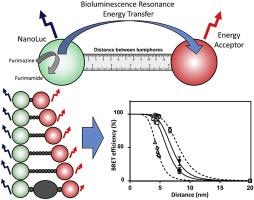当前位置:
X-MOL 学术
›
Anal. Chim. Acta X
›
论文详情
Our official English website, www.x-mol.net, welcomes your
feedback! (Note: you will need to create a separate account there.)
Experimental determination of the Bioluminescence Resonance Energy Transfer (BRET) Förster distances of NanoBRET and red-shifted BRET pairs
Analytica Chimica Acta: X Pub Date : 2020-11-01 , DOI: 10.1016/j.acax.2020.100059 Felix Weihs , Jian Wang , Kevin D.G. Pfleger , Helen Dacres
Analytica Chimica Acta: X Pub Date : 2020-11-01 , DOI: 10.1016/j.acax.2020.100059 Felix Weihs , Jian Wang , Kevin D.G. Pfleger , Helen Dacres

|
Bioluminescence Resonance Energy Transfer (BRET) is widely applied to study protein-protein interactions, as well as increasingly to monitor both ligand binding and molecular rearrangements. The Förster distance (R0) describes the physical distance between the two chromophores at which 50% of the maximal energy transfer occurs and it depends on the choice of RET components. R0 can be experimentally determined using flexible peptide linkers of known lengths to separate the two chromophores. Knowledge of the R0 helps to inform on the choice of BRET system. For example, we have previously shown that BRET2 exhibits the largest R0 to date for any genetically encoded RET pair, which may be advantageous for investigating large macromolecular complexes if its issues of low and fast-decaying bioluminescence signal can be accommodated. In this study we have determined R0 for a range of bright and red-shifted BRET pairs, including NanoBRET with tetramethylrhodamine (TMR), non-chloro TOM (NCT), mCherry or Venus as acceptor, and BRET6, a red-shifted BRET2-like system. This study revealed R0 values of 6.15 nm and 6.94 nm for NanoBRET using TMR or NCT as acceptor ligands, respectively. R0 was 5.43 nm for NanoLuc-mCherry, 5.59 nm for NanoLuc-Venus and 5.47 nm for BRET6. This extends the palette of available BRET Förster distances, to give researchers a better-informed choice when considering BRET systems and points towards NanoBRET with NCT as a good alternative to BRET2 as an analysis tool for large macromolecular complexes.
中文翻译:

NanoBRET 和红移 BRET 对的生物发光共振能量转移 (BRET) 福斯特距离的实验测定
生物发光共振能量转移 (BRET) 被广泛应用于研究蛋白质 - 蛋白质相互作用,以及越来越多地监测配体结合和分子重排。Förster 距离 (R0) 描述了两个发色团之间发生 50% 最大能量转移时的物理距离,它取决于 RET 组件的选择。R0 可以通过使用已知长度的柔性肽接头来分离两个发色团来通过实验确定。R0 的知识有助于告知 BRET 系统的选择。例如,我们之前已经表明,对于任何基因编码的 RET 对,BRET2 表现出迄今为止最大的 R0,如果可以适应其低且快速衰减的生物发光信号的问题,这可能有利于研究大分子复合物。在这项研究中,我们确定了一系列明亮和红移的 BRET 对的 R0,包括带有四甲基罗丹明 (TMR)、非氯 TOM (NCT)、mCherry 或 Venus 作为受体的 NanoBRET,以及 BRET6,一种红移的 BRET2-喜欢系统。该研究揭示了使用 TMR 或 NCT 作为受体配体的 NanoBRET 的 R0 值分别为 6.15 nm 和 6.94 nm。NanoLuc-mCherry 的 R0 为 5.43 nm,NanoLuc-Venus 的 R0 为 5.59 nm,BRET6 的 R0 为 5.47 nm。这扩展了可用 BRET Förster 距离的调色板,为研究人员在考虑 BRET 系统时提供更明智的选择,并指出 NanoBRET 与 NCT 作为 BRET2 的良好替代品,作为大型大分子复合物的分析工具。mCherry 或 Venus 作为受体,以及 BRET6,一种红移 BRET2 样系统。该研究揭示了使用 TMR 或 NCT 作为受体配体的 NanoBRET 的 R0 值分别为 6.15 nm 和 6.94 nm。NanoLuc-mCherry 的 R0 为 5.43 nm,NanoLuc-Venus 的 R0 为 5.59 nm,BRET6 的 R0 为 5.47 nm。这扩展了可用 BRET Förster 距离的调色板,为研究人员在考虑 BRET 系统时提供更明智的选择,并指出 NanoBRET 与 NCT 作为 BRET2 的良好替代品,作为大型大分子复合物的分析工具。mCherry 或 Venus 作为受体,以及 BRET6,一种红移 BRET2 样系统。该研究揭示了使用 TMR 或 NCT 作为受体配体的 NanoBRET 的 R0 值分别为 6.15 nm 和 6.94 nm。NanoLuc-mCherry 的 R0 为 5.43 nm,NanoLuc-Venus 的 R0 为 5.59 nm,BRET6 的 R0 为 5.47 nm。这扩展了可用 BRET Förster 距离的调色板,为研究人员在考虑 BRET 系统时提供更明智的选择,并指出 NanoBRET 与 NCT 作为 BRET2 的良好替代品,作为大型大分子复合物的分析工具。
更新日期:2020-11-01
中文翻译:

NanoBRET 和红移 BRET 对的生物发光共振能量转移 (BRET) 福斯特距离的实验测定
生物发光共振能量转移 (BRET) 被广泛应用于研究蛋白质 - 蛋白质相互作用,以及越来越多地监测配体结合和分子重排。Förster 距离 (R0) 描述了两个发色团之间发生 50% 最大能量转移时的物理距离,它取决于 RET 组件的选择。R0 可以通过使用已知长度的柔性肽接头来分离两个发色团来通过实验确定。R0 的知识有助于告知 BRET 系统的选择。例如,我们之前已经表明,对于任何基因编码的 RET 对,BRET2 表现出迄今为止最大的 R0,如果可以适应其低且快速衰减的生物发光信号的问题,这可能有利于研究大分子复合物。在这项研究中,我们确定了一系列明亮和红移的 BRET 对的 R0,包括带有四甲基罗丹明 (TMR)、非氯 TOM (NCT)、mCherry 或 Venus 作为受体的 NanoBRET,以及 BRET6,一种红移的 BRET2-喜欢系统。该研究揭示了使用 TMR 或 NCT 作为受体配体的 NanoBRET 的 R0 值分别为 6.15 nm 和 6.94 nm。NanoLuc-mCherry 的 R0 为 5.43 nm,NanoLuc-Venus 的 R0 为 5.59 nm,BRET6 的 R0 为 5.47 nm。这扩展了可用 BRET Förster 距离的调色板,为研究人员在考虑 BRET 系统时提供更明智的选择,并指出 NanoBRET 与 NCT 作为 BRET2 的良好替代品,作为大型大分子复合物的分析工具。mCherry 或 Venus 作为受体,以及 BRET6,一种红移 BRET2 样系统。该研究揭示了使用 TMR 或 NCT 作为受体配体的 NanoBRET 的 R0 值分别为 6.15 nm 和 6.94 nm。NanoLuc-mCherry 的 R0 为 5.43 nm,NanoLuc-Venus 的 R0 为 5.59 nm,BRET6 的 R0 为 5.47 nm。这扩展了可用 BRET Förster 距离的调色板,为研究人员在考虑 BRET 系统时提供更明智的选择,并指出 NanoBRET 与 NCT 作为 BRET2 的良好替代品,作为大型大分子复合物的分析工具。mCherry 或 Venus 作为受体,以及 BRET6,一种红移 BRET2 样系统。该研究揭示了使用 TMR 或 NCT 作为受体配体的 NanoBRET 的 R0 值分别为 6.15 nm 和 6.94 nm。NanoLuc-mCherry 的 R0 为 5.43 nm,NanoLuc-Venus 的 R0 为 5.59 nm,BRET6 的 R0 为 5.47 nm。这扩展了可用 BRET Förster 距离的调色板,为研究人员在考虑 BRET 系统时提供更明智的选择,并指出 NanoBRET 与 NCT 作为 BRET2 的良好替代品,作为大型大分子复合物的分析工具。











































 京公网安备 11010802027423号
京公网安备 11010802027423号